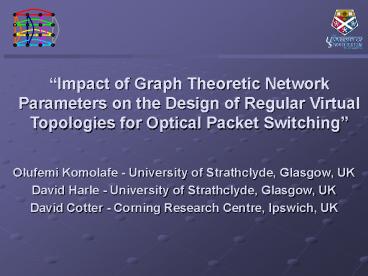Enterprise Network Design Methods - PowerPoint PPT Presentation
1 / 43
Title:
Enterprise Network Design Methods
Description:
ICC 2002 ' ... ICC 2002. Generate large number of unique randomly connected networks ... ICC 2002. Simulated annealing (SA) modelled on cooling of molecules to ... – PowerPoint PPT presentation
Number of Views:43
Avg rating:3.0/5.0
Title: Enterprise Network Design Methods
1
Impact of Graph Theoretic Network Parameters on
the Design of Regular Virtual Topologies for
Optical Packet Switching
Olufemi Komolafe - University of Strathclyde,
Glasgow, UK David Harle - University of
Strathclyde, Glasgow, UK David Cotter - Corning
Research Centre, Ipswich, UK
2
Introduction
ARBITRARY PHYSICAL TOPOLOGIES Contentions highly
probable Complex routing schemes needed
OPTICAL PACKET SWITCHING Minimise/avoid optical
buffering Minimise routing complexity
BUT
3
Introduction
ARBITRARY PHYSICAL TOPOLOGIES Contentions highly
probable Complex routing schemes needed
OPTICAL PACKET SWITCHING Minimise/avoid optical
buffering Minimise routing complexity
Multiprocessor inter-connection architectures
4
Approach
Map MIA nodes onto physical topology
Exemplar multi-processor interconnection
architecture (MIA)
Physical topology
5
Approach
Establish lightpaths between nodes
Exemplar multi-processor interconnection
architecture (MIA)
Physical topology
6
Numerous different mappings
7
(No Transcript)
8
(No Transcript)
9
(No Transcript)
10
(No Transcript)
11
(No Transcript)
12
(No Transcript)
13
(No Transcript)
14
Previous Work
- Different architectures
- Manhattan Street Network, Hypercube, Shufflenet
- Different optimisation techniques
- AI techniques
- genetic algorithms, tabu search, simulated
annealing - heuristic algorithms
- hill climbing, random search
- Different costs
- number of wavelengths, inter-nodal distances,
mean lightpath length
15
BUT Most previous work of an ad hoc
nature Only specific physical topologies
considered No insight into parameters of
physical topology that affect optimisation results
16
Motivation
What parameter(s) of a physical topology
determines the efficacy of regular virtual
topology design?
17
Approach
- Generate large number of unique randomly
connected networks - calculate different parameters
- degree (mean, max, variance, STD, CV)
- inter-nodal distance (mean, max, variance, STD,
CV) - number of bridges
- bounds on cost
- Use heuristics to seek optimal solutions
- Investigate relationship between network
parameters and optimisation result
18
Exemplar MIA
Manhattan Street Network
- Clockwork Routing
- Simple packet routing
- No optical contentions
- Favourable performance
- No resequencing _at_ destinations
19
Cost
- Mean lightpath length
- impacts number of hops packets traverse
- affects number of ? needed
- indicates number of optical cross-connects
traversed between adjacent MSN nodes - affects deployment of optical amplifiers
consumption of other network resources
20
Optimisation Techniques
- Simulated annealing (SA)
- modelled on cooling of molecules to form crystal
- uphill moves allowed with decreasing probability
- Genetic algorithms (GA)
- modelled on natural evolution
- synergistic combination of solutions to find
optimum - Use of these radically different optimisation
techniques engenders confidence in findings
21
Network Classification Degree
- Mean degree varied
- i.e. number of links varied
- uniform random distribution of links
- Distribution of nodal degree varied
- i.e. number of links constant BUT
- non-uniform random distribution of links
- existence of hub nodes
22
Variation of Mean Degree
23
Variation of Mean Degree
Exemplar 16-node networks
24
Variation of Mean Degree
Exemplar 64-node networks
25
Variation of Mean Degree
- Exemplar results statistically verified
- 3000 unique randomly connected networks
considered
26
Variation of Degree Distribution
- Achieved by varying number of hub nodes
No hub node
Single hub node
Mean degree 3 Max degree 5 CV degree 0.404
Mean degree 3 Max degree 10 CV degree 0.689
27
Variation of Degree Distribution
Average results for 500 unique 36-node
networks Mean degree 3
28
Variation of Degree Distribution
Average results for 500 unique 36-node
networks Mean degree 7
29
Observations Initial Cost
Initial mean lightpath length falls with
increasing CV degree
Fall more pronounced for lower mean degree
Mean degree 3
Mean degree 7
30
Explanation Initial Cost Fall
- Why does initial cost fall with rising degree CV?
- Counter-intuitive result
- expect uniform distribution of links to be
better than having hub nodes - Estimate for initial cost introduced to explain
results - What would be the resulting mean lightpath length
for a typical random (un-optimised) embedding?
31
Estimate for Initial Cost
Random Embedding Each MSN node mapped to
arbitrary physical topology node
32
Estimate for Initial Cost
Random Embedding Each MSN node mapped to
arbitrary physical topology node Neighbours
mapped to arbitrary physical topology nodes
33
Estimate for Initial Cost
Random Embedding Mean lightpath length Mean
distance to 4 arbitrary nodes i.e. Mean
inter-nodal distance
34
Explanation Initial Cost Fall
- Mean inter-nodal distance found to be excellent
estimate for initial mean lightpath length
Effect of CV degree on mean inter-nodal distance
Effect of CV degree on initial mean lightpath
length
35
Explanation Initial Cost Fall
36
Observations Final Cost
Final mean lightpath length rises with increasing
CV degree
Rise more pronounced for lower mean degree
Mean degree 3
Mean degree 7
37
Explanation Final Cost Rise
- Why does final cost rise with rising degree CV?
- Estimate for improvement margin on initial cost
introduced to explain results - What parameter of a network determines the
improvement obtainable on an random initial
solution?
38
Estimate for Improvement Margin
CV degree insufficient to characterise
improvement obtainable!
39
Estimate for Improvement Margin
Spread in inter-nodal distances indicates margin
for improvement
40
Explanation Final Cost Rise
- CV inter-nodal distances indicative of
improvement obtainable on initial embedding - Low spread in inter-nodal distance
- all mappings of MSN onto network produce similar
results - High spread in inter-nodal distance
- significant improvement obtainable if adjacent
MSN nodes placed onto physical topology nodes
near each other
41
Explanation Final Cost Rise
42
Conclusions
- Addressing ad hoc approach to regular virtual
topology design - What parameters of physical topologies affect the
optimisation results? - Mean inter-nodal distance ? initial embedding
cost - Spread in inter-nodal distance ? margin of
improvement - Suggest principles applicable to other areas in
telecommunication network design
43
THANKS































